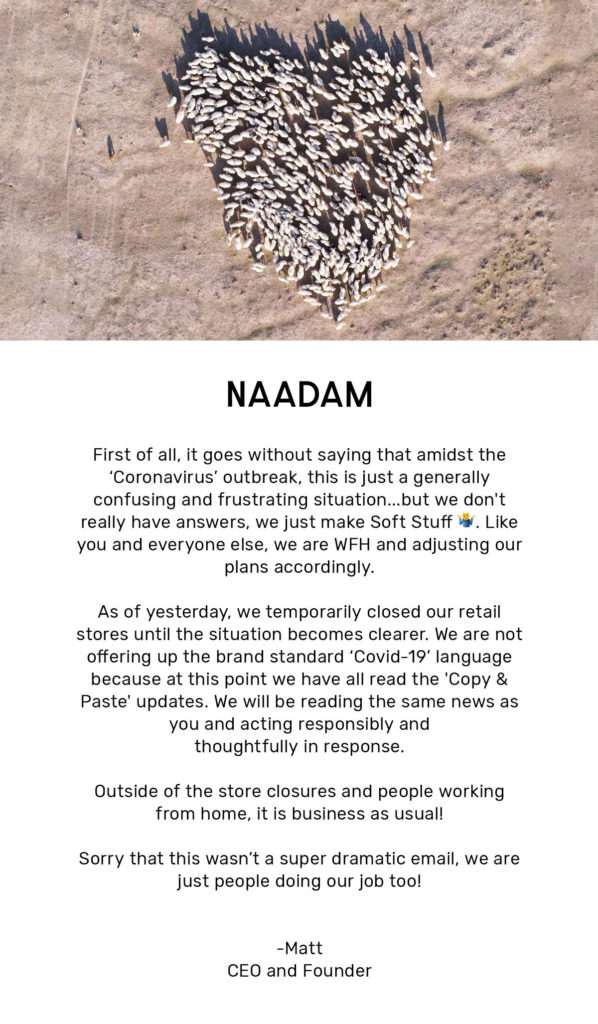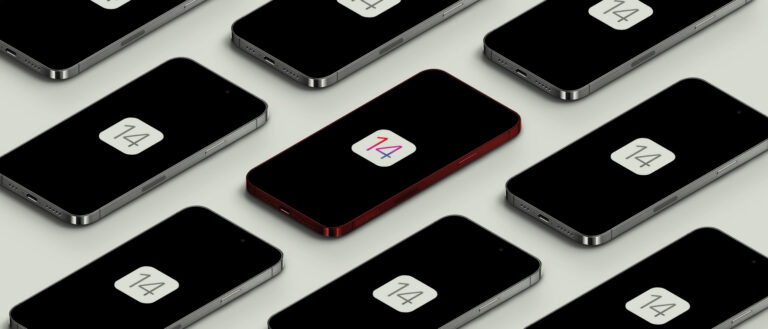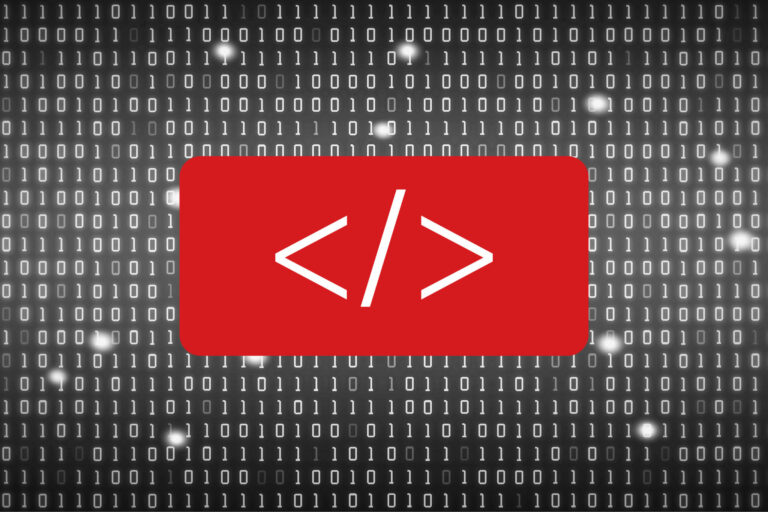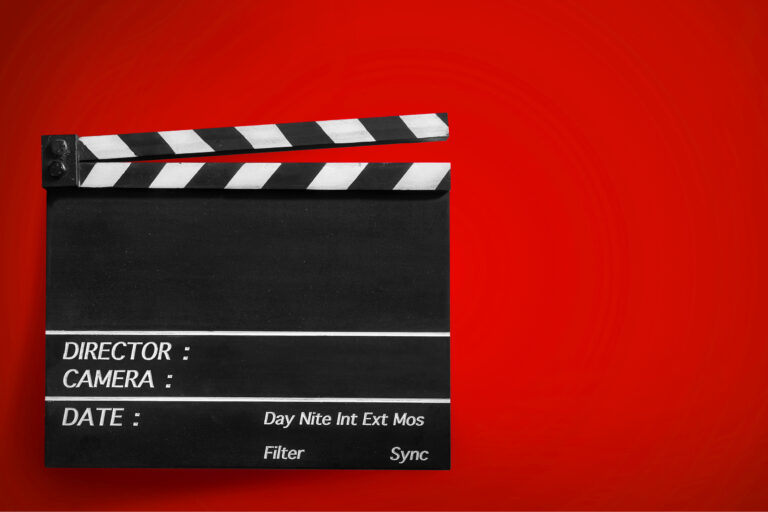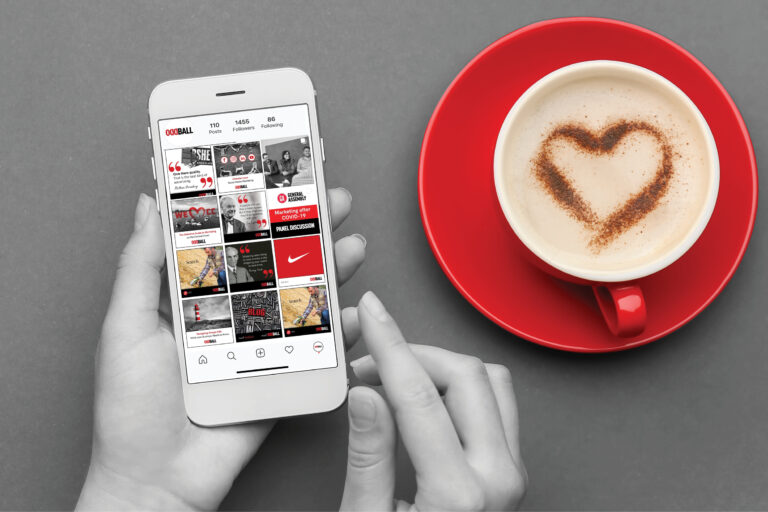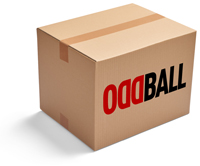The way your business both handles and communicates with your audience during COVID-19 may define it going forward. The sort of messages you put out to the public through your marketing will ultimately help people decide if they are happy to buy from you – now and in the coming months.
“Copy creates connection and connection creates conversions.” – Amy Porterfield
The first step to connect with your audience right now – if you haven’t done it already – is acknowledging the Coronavirus crisis. Simply and sensitively.
Next up – you need to review the way you present your business to the public through your brand messaging.
In the case of large, corporate companies, brand messaging is always deliberate, defined and consistent. They follow strict brand guidelines and styles. They write their copy a certain way, publish only certain kinds of images, and communicate with customers in a certain language.
In the case of small to medium businesses, brand messaging can be a little harder to refine without a corporate marketing and communications team to back you up, but it’s just as important to get your messaging right.
Your messaging can include but is not limited to:
- The kind of language you write social media posts in
- The tone of voice used across your website
- Your choice of words on your homepage relating to COVID-19
- The way you answer the phone to new customers
- Your online contact form
- How you respond to Google Reviews of your business
- Order confirmation emails to your customers
- The headline you print on a large, roadside banner
- The ‘thank you’ email you send to new subscribers
- The frequency of posts, articles or emails you publish
- That Facebook Event you still haven’t updated since COVID-19 hit!
And that’s just the start of where your messaging lives and breeds.
Essentially, the style and tone of your messaging is shaped by how you talk to and interact with your audience across ALL marketing channels. The language you choose to use and the images you select to represent your business give it a personality, even if you’re not fully aware of it!
As a business owner, manager or marketer, you have control over most of your messaging – but are you actively using it?
Knowing how to control your messaging is extremely valuable at the moment, considering COVID-19 is putting a heap of pressure on businesses to follow its lead.
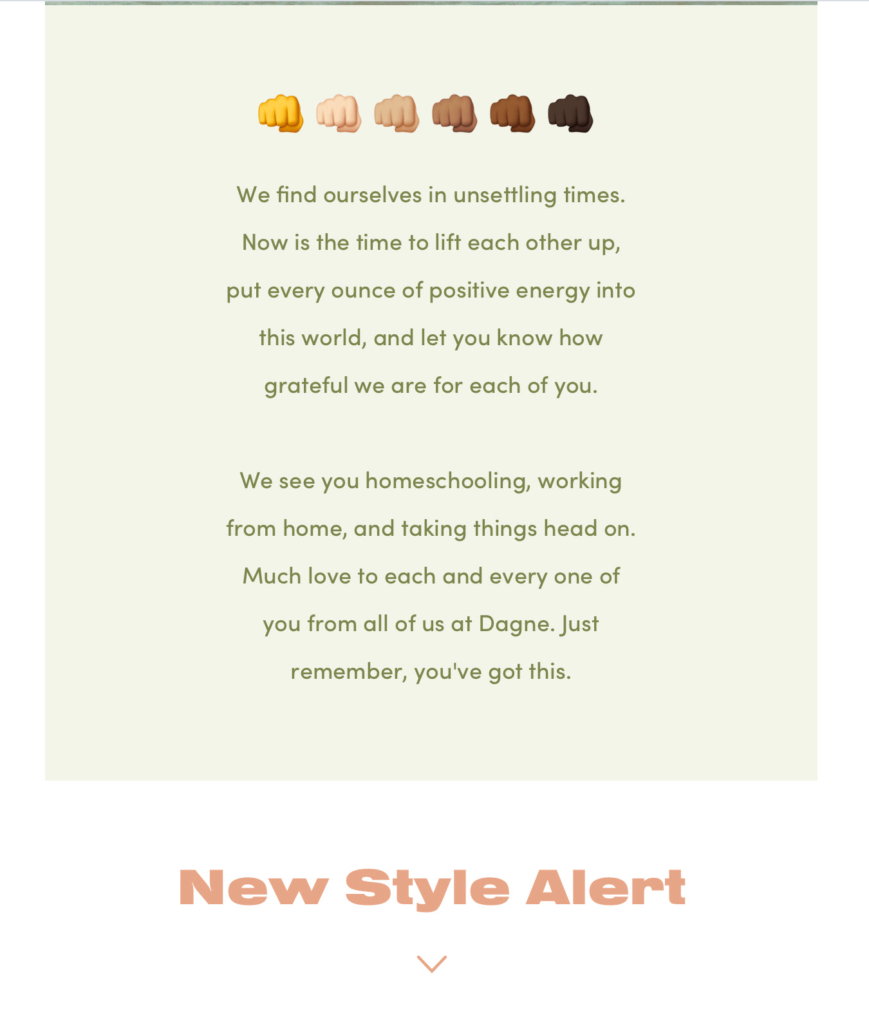 Example of adapted brand messaging for a fashion brand
Example of adapted brand messaging for a fashion brand
Get the Mess out of your Messaging
During COVID-19, the way businesses represent their brand through their messaging – both online and in person – is a conscious, operational choice.
We are seeing some businesses doing amazingly well adapting their websites and social media to the global pandemic. They are regularly keeping their customers informed on changes to opening times, contactless delivery options, takeaway menus, and even starting email newsletters for the first time!
Meanwhile, other businesses are clearly struggling to make even basic changes to their marketing messages. They are failing to help keep their confused customers up to date. Hibernating your marketing messages may feel safe now, but ignoring COVID-19 can only hurt a brand in the long run. Your best move is to adapt.
How do I adapt my Brand Messaging?
Changing your brand’s messaging overall is a HUGE job. We are definitely not suggesting you attempt that alongside everything else going on. The truth is that even without COVID-19 overstaying its welcome and devastating the global economy, brand messaging is always going to be MESSY. And it’s forever evolving.
A business can never have total control over how it looks, sounds and acts – but as a business owner or marketer you can manage messaging effectively through the content you publish.
We suggest you review how your business looks and sounds in light of the international panic, uncertainty, and worry over the Coronavirus outbreak. There are a few easy ways to get started – we’ve outlined them clearly below for you to put into action.
Set aside a few hours to sit down in front of the computer and sense-check the marketing material your business currently has live. Pretend you are a customer if it helps, searching online for your product or service…
Does your homepage make sense in the current, restrictive climate?
Are your ads talking to customers who are no longer there?
Can you spot any faux pas in your copy that may lose a potential customer?
Once you’ve scanned your website, social media, public profiles, signage and any emails you routinely send – run through these 3 steps:
1. Replace Trigger Words
The risk of coming off as insensitive or even patronising is at its peak. It’s amazing what damage a few poorly placed words or phrases can cause! Your current marketing and advertising deserves a quick audit to check your brand is avoiding any negative sentiment in the language used. There are certain words you want to avoid like the plague to stay in touch with your customers (that sentence is the perfect example for you!).
Examples of trigger words you want to edit out of top-level marketing material includes:
- Going viral
- Killer deal
- Spread, contagious, infectious
- References to gatherings or event
And as if it wasn’t obvious in the above example, puns are firmly in the no-go zone.
Example of honest, clear messaging
2. Replace Insensitive Images
A sense check of the images your brand is currently using to promote and advertise could save you from an awkward customer complaint – or even prevent putting potential customers off with your lack of sensitivity. This is a self explanatory step, as we all are fully aware of the kind of images that make us hesitate, or cringe, at the moment.
Images you want to replace or avoid on your website, social media and overall marketing include:
- Crowded situations, such as gigs, public transport, clubs or pubs
- Travel related images, such as airport scenes
- People unnecessarily touching, hugging, playing contact sport
- Groups working together closely in office settings, or at a gym
- People gathered around a phone, bar, dinner table etc.
- Handshakes
- Socialising in large groups in public
- …Probably bats or pigs
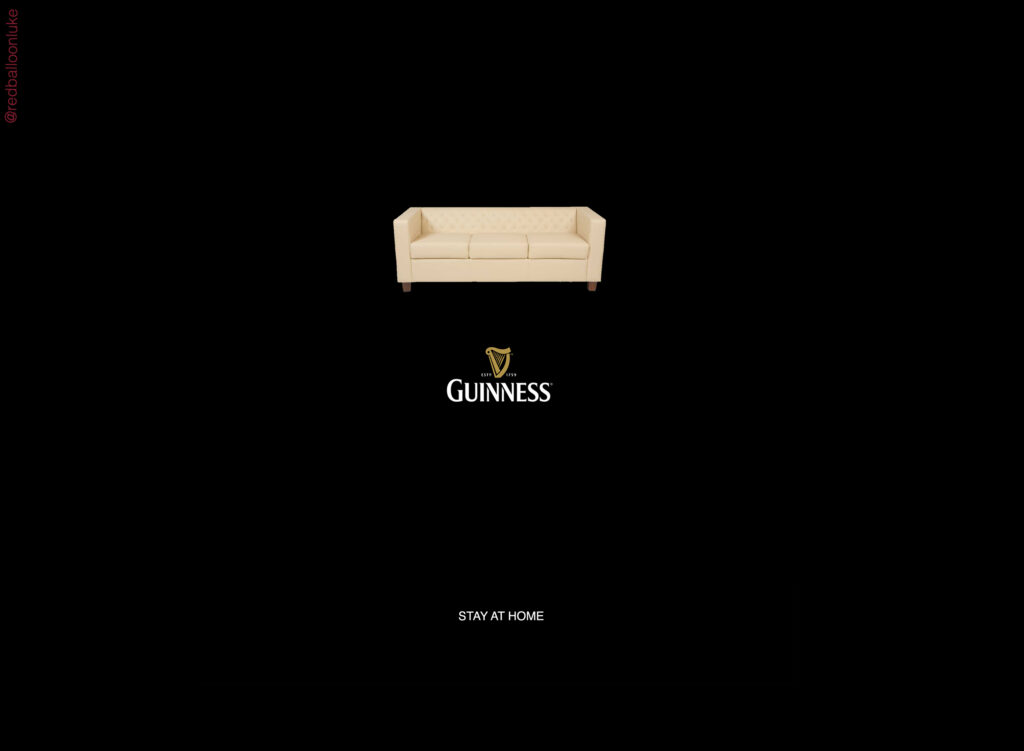
Example of adjusting ad imagery
3. Positive, Emphatic Tone of Voice
We’ve all now received hundreds of COVID-19 themed emails and read thousands of social media posts since the outbreak started. One thing stands out: businesses now need to communicate emphatically to build trust in their brand.
Interestingly, if you have already published announcements on your business’ reaction and operational changes to COVID-19, you’ve probably already set an impression to your audience. It’s never too late to revisit and edit announcement messages in regards to the virus, ensuring they follow this style:
- Be clear and concise – get to the point as people are being bombarded
- Don’t repeat the news headlines or stats – people will visit other sites for this information
- Messages shouldn’t feel panicked, rushed or threatening
- Messages should feel supportive, calm and understanding
- Remove negative sentiment, favour positivity
- Avoid wit and humour
- Avoid urgency – nothing is more urgent than Coronavirus now
- Emphasise your availability and flexibility for customers
- Reference your local community, if relevant
A professional copywriter is your best option when it comes to shaping your messaging to benefit your business. It’s completely normal to not know where to start when trying to develop your “tone of voice”, and they can always tackle your text with an outside perspective (they can think like a customer).
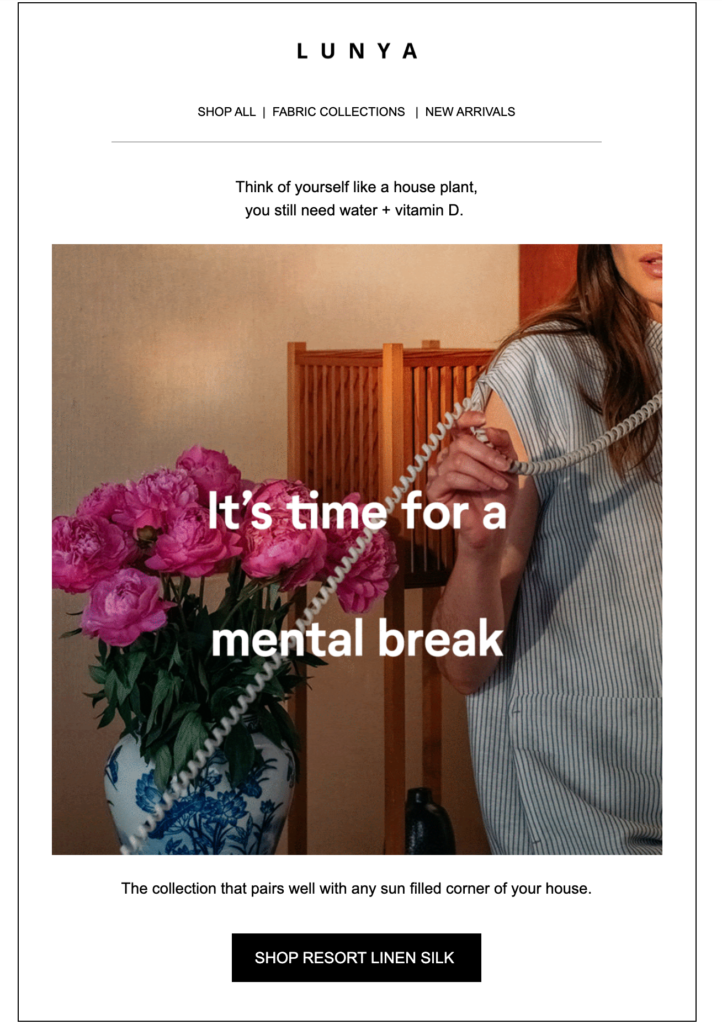 Example of brand messaging with empathy
Example of brand messaging with empathy
